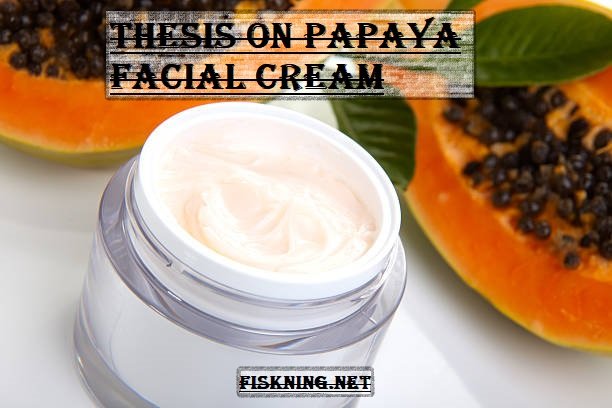Introduction
The beauty and skincare market has seen a significant surge in demand for natural and organic products in recent years. Among the various ingredients that have gained popularity for their beneficial properties, papaya stands out due to its numerous health advantages for the skin. This blog post aims to explore a thesis on papaya facial cream, delving into its origins, ingredients, benefits, potential formulations, and the science behind its effectiveness.
Understanding Papaya A Nutritional Powerhouse
Papaya, scientifically known as Carica papaya, is a tropical fruit native to Central America and widely cultivated in various parts of the world. Beyond its delicious taste and nutritional value, papaya is rich in enzymes, vitamins, and antioxidants that make it a potent ally for skincare.
Nutritional Content
Papaya is packed with essential nutrients, including:
- Vitamins: Particularly rich in vitamin C, vitamin A, and folate, all of which play crucial roles in skin health and regeneration.
- Antioxidants: Papaya contains various antioxidants, such as beta-carotene and flavonoids, which help combat free radicals that contribute to skin aging.
- Enzymes: The enzyme papain, found in papaya, aids in exfoliation and the removal of dead skin cells, making way for fresher, healthier skin.
The Science Behind Papaya and Its Benefits for the Skin
Papaya’s multifaceted benefits for the skin make it an ideal ingredient for facial creams. The efficacy of papaya in skincare can be attributed to several key factors:
1. Exfoliation
The enzyme papain helps to gently exfoliate the skin, promoting cell turnover and helping to diminish the appearance of dark spots and blemishes. This natural exfoliation process results in smoother, more radiant skin.
2. Hydration
Papaya is known for its moisturizing properties, which help to keep the skin hydrated. The high water content in papaya, combined with its nutrient-rich profile, supports skin barrier function, preventing dryness and flakiness.
3. Anti-inflammatory Properties
The antioxidants and vitamins present in papaya possess anti-inflammatory properties that can help soothe irritated skin, reduce redness, and improve overall skin tone. This makes it particularly beneficial for individuals with sensitive or acne-prone skin.
4. Brightening Effect
The high vitamin C content in papaya aids in brightening the skin and reducing the appearance of hyperpigmentation. Regular use of papaya-derived products can lead to an even skin tone and a luminous complexion.
5. Anti-aging Benefits
Papaya’s antioxidant properties help to combat the signs of aging by neutralizing free radicals, which contribute to fine lines and wrinkles. Additionally, the vitamins and enzymes in papaya promote collagen production, enhancing skin elasticity and firmness.
Formulating Papaya Facial Cream
When developing a thesis on papaya facial cream, it is essential to outline potential formulations. The effectiveness of the cream relies not only on papaya but also on the other complementary ingredients used. Below are some formulations to consider:
Basic Papaya Facial Cream
Ingredients:
- Papaya extract
- Coconut oil (for moisturizing and antibacterial properties)
- Shea butter (for its rich fatty acid content)
- Essential oils (such as tea tree oil or lavender for additional benefits)
- Natural emulsifiers and stabilizers (to achieve the desired texture)
Process:
- Extract papaya juice or puree fresh papaya.
- Combine papaya with melted shea butter and coconut oil.
- Add essential oils and emulsifiers.
- Mix thoroughly until a smooth, creamy texture is achieved.
- Pour into sterilized containers and label.
Advanced Papaya Facial Cream with Active Ingredients
Ingredients:
- Papaya extract
- Niacinamide (for brightening and anti-aging effects)
- Hyaluronic acid (for deep hydration)
- Aloe vera gel (for soothing and anti-inflammatory properties)
- Natural preservatives (to ensure product longevity)
Process:
- Prepare papaya extract by blending and straining fresh papaya.
- Combine with hyaluronic acid and aloe vera gel.
- Add niacinamide and other active ingredients.
- Blend until uniformly mixed, ensuring a light, airy texture.
- Package in airtight containers to prevent degradation.
Conclusion
The exploration of papaya’s role in skincare, particularly in facial creams, offers exciting possibilities for natural and effective beauty solutions. The nutritional and therapeutic properties of papaya make it a valuable ingredient in formulating facial creams that cater to a variety of skin concerns, from dryness and irritation to signs of aging and uneven skin tone.
As consumer interest in natural skincare products continues to grow, further research and experimentation in the formulation of papaya facial creams will likely yield innovative products that harness the power of this nutrient-rich fruit. A thesis centered on this topic can contribute significantly to the field of cosmetic formulation and organic skincare development, bridging the gap between nature and effective skincare solutions.
By embracing the benefits of papaya, skincare enthusiasts and formulators can promote healthier, more radiant skin through the use of natural ingredients that are both effective and environmentally friendly.
